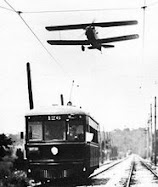
So we have these massive 30 and 40 passenger diesel buses, growling up and down the roadways of Jacksonville, the backbone of a future inter modal and inter county Transit network. The planners are already hard a work putting pens to paper and hitting the keyboards to crunch the numbers. There are still unanswered questions. If Baldwin ends up on commuter rail, what about Fargo? If Yulee is a terminus, then what about Callahan? Some interesting thoughts on making the whole metro transit inclusive comes from a small city and a big think-tank in Central Oregon.
Flexible Transit? Big lessons from little Bend, Oregon by Sreya Sarkar Monday,
In September 2006, after six years of deliberation and planning and with much fanfare, Bend began its fixed-route bus service, Bend Area Transit (BAT). Seven bus lines within the Bend city limits charge adults and youth $1 and seniors 50 cents to ride. The city also continued to offer the general public the previously existing dial-a-ride bus service with door-to-door transit.The population explosion in the Deschutes County communities seemed to demand this new fixed-route service. Yet, after just a year of service, when Bend residents were asked in a regional survey if they would like to see BAT expand its services, they offered a mixed response: They would like to see it expand but would not like to pay more taxes to maintain it.
Over the past year, a committee of public and private leaders representing the three Central Oregon Counties (Deschutes, Jefferson and Crook) have worked to create a regional framework to address a more efficient, effective and equitable use of alternative transportation services. The committee, called the Central Oregon Mobility Consortium, has been formally established under the Central Oregon Intergovernmental Council (COIC) and has generated private funding to conduct the region’s first comprehensive survey of alternative transportation services.The survey results clearly show that overwhelming support exists for transit services based on real market demand. The transit model promoted by the Mobility Consortium is very different from that followed by traditional public transit agencies which typically provide one or two distinct services. The Consortium feels that the traditional fixed-route public transit model may fit the needs of some big cities, but definitely not those of the scattered and low population density communities of Central Oregon.The Consortium’s plan, therefore, is to pool together the region’s public and private transportation resources (including municipal buses, school buses, shuttles, vans and even taxicabs) and match the modes of transportation with customers’ needs. Critical to this approach of providing flexible services and allowing customers to choose the type of service that best suits them in terms of price, convenience and time is the development and operation of a “one stop” information, reservation and dispatch center. This idea is unique in that it brings in the private sector to share the risk in developing and delivering services.Cascade Policy Institute recently asked David Foote, the consultant for the Mobility Consortium, if the Consortium has a specific plan for the low-income population in Central Oregon. His response was that there is no separate plan for the low-income population because the Consortium does not believe in segregating low-, middle- and high-income populations. He said services would suit the needs of different populations, including the low-income, the physically challenged and the elderly.However, the Consortium feels that traditional public transit is “subsidy” based. Therefore, very little incentive exists for the transit agency to be customer-focused. In many cases this results in low-income or transit dependent riders subsidizing more affluent riders. When asked about the feasibility of using privately operated automobiles (or jitneys) that could serve as flexible quasi-public transportation for low-income populations in Central Oregon, Foote thought it is an idea that needs to be “investigated.” He is of the opinion that if jitneys offer inexpensive and flexible transportation service to people who need it, there is no reason why they should not be considered as a viable transportation option.There are legal bans (or at least heavy regulations) stifling jitney services in most American cities. When and where the traditional fixed-route public transit model does not work, such legal bans should be lifted. There are a number of ways jitney-like services can be reasonably regulated without forcing jitney businesses to cease to exist altogether. A good way would be starting a system of user charges for jitney operators, including a requirement for financial responsibility for all vehicles instead of a high operating bond which unduly penalizes jitneys.Since Central Oregon has a skeletal and expensive public transit service that only serves people within the Bend city limit, a more comprehensive regional transportation system is urgently needed. It could include private jitney services, as well as special shuttle services for the physically challenged. The Mobility Consortium realizes that federal and state regulations sometimes create undue barriers to the better utilization of resources. The result is increased costs for providing public transportation services and low-ridership. That is the reason why it is willing to fight the legal battle against such regulations. Its main aim is to provide Central Oregonians with transportation choices and let them determine the service that best meets their requirements, based on the value of the service.Public transit is ultimately for the use and convenience of the public and not of the transit providers. The fact that Central Oregonians are convinced that the market can take care of public demands better than the traditional public transit agency is a starting point for considering including more private enterprises in the field of public transit.Sreya Sarkar is Director of the Wheels to Wealth Project at Cascade Policy Institute, a think tank based in Portland, Oregon.



























No comments:
Post a Comment